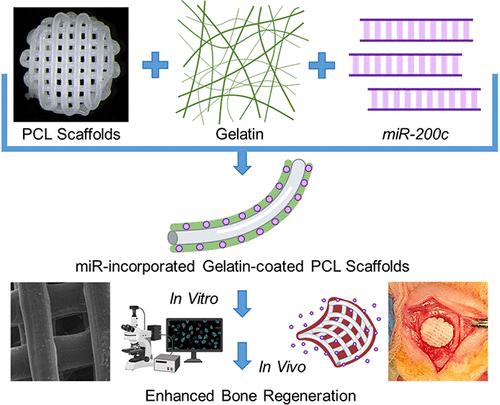当前位置:
X-MOL 学术
›
ACS Biomater. Sci. Eng.
›
论文详情
Our official English website, www.x-mol.net, welcomes your feedback! (Note: you will need to create a separate account there.)
MicroRNA-200c Release from Gelatin-Coated 3D-Printed PCL Scaffolds Enhances Bone Regeneration
ACS Biomaterials Science & Engineering ( IF 5.8 ) Pub Date : 2024-03-26 , DOI: 10.1021/acsbiomaterials.3c01105 Matthew T. Remy 1, 2 , Chawin Upara 1 , Qiong J. Ding 1 , Jacob M. Miszuk 1 , Hongli Sun 1 , Liu Hong 1
ACS Biomaterials Science & Engineering ( IF 5.8 ) Pub Date : 2024-03-26 , DOI: 10.1021/acsbiomaterials.3c01105 Matthew T. Remy 1, 2 , Chawin Upara 1 , Qiong J. Ding 1 , Jacob M. Miszuk 1 , Hongli Sun 1 , Liu Hong 1
Affiliation

|
The fabrication of clinically relevant synthetic bone grafts relies on combining multiple biodegradable biomaterials to create a structure that supports the regeneration of defects while delivering osteogenic biomolecules that enhance regeneration. MicroRNA-200c (miR-200c) functions as a potent osteoinductive biomolecule to enhance osteogenic differentiation and bone formation; however, synthetic tissue-engineered bone grafts that sustain the delivery of miR-200c for bone regeneration have not yet been evaluated. In this study, we created novel, multimaterial, synthetic bone grafts from gelatin-coated 3D-printed polycaprolactone (PCL) scaffolds. We attempted to optimize the release of pDNA encoding miR-200c by varying gelatin types, concentrations, and polymer crosslinking materials to improve its functions for bone regeneration. We revealed that by modulating gelatin type, coating material concentration, and polymer crosslinking, we effectively altered the release rates of pDNA encoding miR-200c, which promoted osteogenic differentiation in vitro and bone regeneration in a critical-sized calvarial bone defect animal model. We also demonstrated that crosslinking the gelatin coatings on the PCL scaffolds with low-concentration glutaraldehyde was biocompatible and increased cell attachment. These results strongly indicate the potential use of gelatin-based systems for pDNA encoding microRNA delivery in gene therapy and further demonstrate the effectiveness of miR-200c for enhancing bone regeneration from synthetic bone grafts.
中文翻译:

MicroRNA-200c 从明胶涂层 3D 打印 PCL 支架中释放,增强骨再生
临床相关的合成骨移植物的制造依赖于组合多种可生物降解的生物材料来创建支持缺损再生的结构,同时提供增强再生的成骨生物分子。 MicroRNA-200c ( miR-200c ) 作为一种有效的骨诱导生物分子,可增强成骨分化和骨形成;然而,维持miR-200c递送以促进骨再生的合成组织工程骨移植物尚未得到评估。在这项研究中,我们利用明胶涂层的 3D 打印聚己内酯 (PCL) 支架创建了新型多材料合成骨移植物。我们尝试通过改变明胶类型、浓度和聚合物交联材料来优化编码miR-200c的 pDNA 的释放,以改善其骨再生功能。我们发现,通过调节明胶类型、涂层材料浓度和聚合物交联,我们有效地改变了编码miR-200c的 pDNA 的释放速率,从而促进了临界尺寸颅骨骨缺损动物模型的体外成骨分化和骨再生。我们还证明,用低浓度戊二醛交联 PCL 支架上的明胶涂层具有生物相容性并增加了细胞附着。这些结果有力地表明了基于明胶的系统在基因治疗中编码 microRNA 递送的 pDNA 的潜在用途,并进一步证明了miR-200c对于增强合成骨移植物骨再生的有效性。
更新日期:2024-03-26
中文翻译:

MicroRNA-200c 从明胶涂层 3D 打印 PCL 支架中释放,增强骨再生
临床相关的合成骨移植物的制造依赖于组合多种可生物降解的生物材料来创建支持缺损再生的结构,同时提供增强再生的成骨生物分子。 MicroRNA-200c ( miR-200c ) 作为一种有效的骨诱导生物分子,可增强成骨分化和骨形成;然而,维持miR-200c递送以促进骨再生的合成组织工程骨移植物尚未得到评估。在这项研究中,我们利用明胶涂层的 3D 打印聚己内酯 (PCL) 支架创建了新型多材料合成骨移植物。我们尝试通过改变明胶类型、浓度和聚合物交联材料来优化编码miR-200c的 pDNA 的释放,以改善其骨再生功能。我们发现,通过调节明胶类型、涂层材料浓度和聚合物交联,我们有效地改变了编码miR-200c的 pDNA 的释放速率,从而促进了临界尺寸颅骨骨缺损动物模型的体外成骨分化和骨再生。我们还证明,用低浓度戊二醛交联 PCL 支架上的明胶涂层具有生物相容性并增加了细胞附着。这些结果有力地表明了基于明胶的系统在基因治疗中编码 microRNA 递送的 pDNA 的潜在用途,并进一步证明了miR-200c对于增强合成骨移植物骨再生的有效性。



























 京公网安备 11010802027423号
京公网安备 11010802027423号